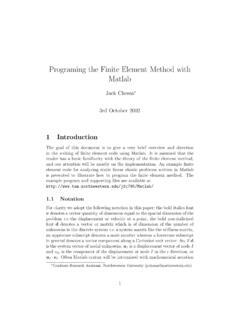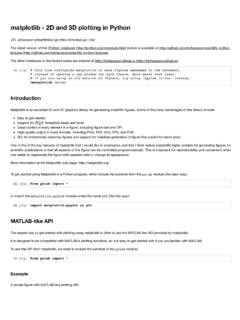Transcription of Plotly - Tutorialspoint
1 Plotly i Plotly About the Tutorial This tutorial is about Canada based technical computing company Plotly which is also known for its URL. Here, you will learn about how to develop data analytics and visualization tools. Moreover, this tutorial describes the features of Plotly 's Python graphing library to make interactive and publication-ready graphs for both online and offline viewing. Audience The tutorial is aptly designed for all those who are passionate about learning online graphing, analytics, and statistics tools. Furthermore, it is for those individuals who have keen interest in understanding how Plotly helps in providing tools for scientific graphing libraries of the computer programming languages such as Python, R, matlab , Perl, Julia, Arduino, and REST. Prerequisites To work with Plotly , you need to create an account on the official website.
2 The details about how to create an account and get login is discussed in the tutorial. If you are novice to knowledge about data analytics, visualization tools or any of the programming languages like Python, R, matlab , Arduino, REST, Julia and Perl, we suggest you to go through tutorials related to these before proceeding with this tutorial. Copyright & Disclaimer Copyright 2019 by Tutorials Point (I) Pvt. Ltd. All the content and graphics published in this e-book are the property of Tutorials Point (I). Pvt. Ltd. The user of this e-book is prohibited to reuse, retain, copy, distribute or republish any contents or a part of contents of this e-book in any manner without written consent of the publisher. We strive to update the contents of our website and tutorials as timely and as precisely as possible, however, the contents may contain inaccuracies or errors.
3 Tutorials Point (I) Pvt. Ltd. provides no guarantee regarding the accuracy, timeliness or completeness of our website or its contents including this tutorial. If you discover any errors on our website or in this tutorial, please notify us at ii Plotly Table of Contents About the Tutorial .. ii Audience .. ii Prerequisites .. ii Copyright & Disclaimer .. ii Table of Contents .. iii 1. Plotly 1. 2. Plotly Environment Setup .. 2. Installation of Python package .. 2. 3. Plotly Online and Offline Plotting .. 6. Settings for online plotting .. 6. Setting for Offline Plotting .. 8. 4. Plotly Plotting Inline with Jupyter Notebook .. 10. 5. Plotly Package Structure .. 12. 6. Plotly Exporting to Static Images .. 14. 7. Plotly Legends .. 16. 8. Plotly Format Axis and Ticks .. 18. Plot with Axis and Tick.
4 18. Plot with Multiple Axes .. 20. 9. Plotly Subplots and Inset 22. Making Subplots .. 22. Inset Plots .. 24. 10. Plotly Bar Chart and Pie Chart .. 26. Bar Chart .. 26. Pie 29. 11. Plotly Scatter Plot, Scattergl Plot and Bubble 33. Scatter Plot .. 33. iii Plotly Scattergl Plot .. 34. Bubble charts .. 35. 12. Plotly Dot Plots and Table .. 38. Dot Plots .. 38. Table in Plotly .. 39. 13. Plotly Histogram .. 42. 14. Plotly Box Plot, Violin Plot and Contour 45. Box 45. Violin Plot .. 47. Contour plot .. 48. Quiver plot .. 50. 15. Plotly Distplots, Density Plot and Error Bar 52. Distplots .. 52. Density Plot .. 53. Error Bar Plot .. 54. 16. Plotly Heatmap .. 58. 17. Plotly Polar Chart and Radar Chart .. 60. Polar Chart .. 60. Radar chart .. 62. 18. Plotly OHLC Chart, Waterfall Chart and Funnel Chart.
5 64. OHLC Chart .. 64. Waterfall chart .. 66. Funnel Chart .. 67. 19. Plotly 3D Scatter and Surface Plot .. 68. 3D Scatter Plot .. 68. 3D Surface Plot .. 69. 20. Plotly Adding 71. 21. Plotly Slider Control .. 78. iv Plotly 22. Plotly FigureWidget Class .. 80. 23. Plotly with Pandas and Cufflinks .. 84. Pandas dataframes from databases .. 86. 24. Plotly with Matplotlib and Chart Studio .. 87. Matplotlib .. 87. Chart Studio .. 88. v 1. Plotly Introduction Plotly Plotly is a Montreal based technical computing company involved in development of data analytics and visualisation tools such as Dash and Chart Studio. It has also developed open source graphing Application Programming Interface (API) libraries for Python, R, matlab , Javascript and other computer programming languages. Some of the important features of Plotly are as follows: It produces interactive graphs.
6 The graphs are stored in JavaScript Object Notation (JSON) data format so that they can be read using scripts of other programming languages such as R, Julia, matlab etc. Graphs can be exported in various raster as well as vector image formats 1. 2. Plotly Environment Setup Plotly This chapter focusses on how to do the environmental set up in Python with the help of Plotly . Installation of Python package It is always recommended to use Python's virtual environment feature for installation of a new package. Following command creates a virtual environment in the specified folder. python -m myenv To activate the so created virtual environment run activate script in bin sub folder as shown below. source bin/activate Now we can install Plotly 's Python package as given below using pip utility.
7 Pip install Plotly You may also want to install Jupyter notebook app which is a web based interface to Ipython interpreter. pip install jupyter notebook Firstly, you need to create an account on website which is available at You can sign up by using the link mentioned herewith and then log in successfully. 2. Plotly Next, obtain the API key from settings page of your dashboard. 3. Plotly Use your username and API key to set up credentials on Python interpreter session. import Plotly (username='test', api_key='**'). A special file named credentials is created in . Plotly subfolder under your home directory. It looks similar to the following: {. "username": "test", "api_key": "**", "proxy_username": "", 4. Plotly "proxy_password": "", "stream_ids": []. }. In order to generate plots, we need to import the following module from Plotly package: import as py import as go module contains the functions that will help us communicate with the Plotly servers.
8 Functions in module generates graph objects. 5. 3. Plotly Online and Offline Plotting Plotly The following chapter deals with the settings for the online and offline plotting. Let us first study the settings for online plotting. Settings for online plotting Data and graph of online plot are save in your account. Online plots are generated by two methods both of which create a unique url for the plot and save it in your Plotly account. () : returns the unique url and optionally open the url. () : when working in a Jupyter Notebook to display the plot in the notebook. We shall now display simple plot of angle in radians vs. its sine value. First, obtain ndarray object of angles between 0 and 2 using arange() function from numpy library. This ndarray object serves as values on x axis of the graph.
9 Corresponding sine values of angles in x which has to be displayed on y axis are obtained by following statements: import numpy as np import math #needed for definition of pi xpoints= (0, *2, ). ypoints= (xpoints). Next, create a scatter trace using Scatter() function in graph_objs module. trace0 = (. x=xpoints, y=ypoints ). data = [trace0]. Use above list object as argument to plot() function. (data, filename = 'Sine wave', auto_open=True). Save following script as import Plotly (username='lathkar', api_key='**'). import as py import as go 6. Plotly import numpy as np import math #needed for definition of pi xpoints= (0, *2, ). ypoints= (xpoints). trace0 = (. x=xpoints, y=ypoints ). data = [trace0]. (data, filename = 'Sine wave', auto_open=True). Execute the above mentioned script from command line.
10 Resultant plot will be displayed in the browser at specified URL as stated below. $ python High five! You successfully sent some data to your account on Plotly . View your plot in your browser at ~lathkar/0. Just above the displayed graph, you will find tabs Plot, Data, Python &Rand Forking history. 7. Plotly Currently, Plot tab is selected. The Data tab shows a grid containing x and y data points. From Python & R tab, you can view code corresponding to current plot in Python, R, JSON, matlab etc. Following snapshot shows Python code for the plot as generated above: Setting for Offline Plotting Plotly allows you to generate graphs offline and save them in local machine. The () function creates a standalone HTML that is saved locally and opened inside your web browser. Use () when working offline in a Jupyter Notebook to display the plot in the notebook.

















